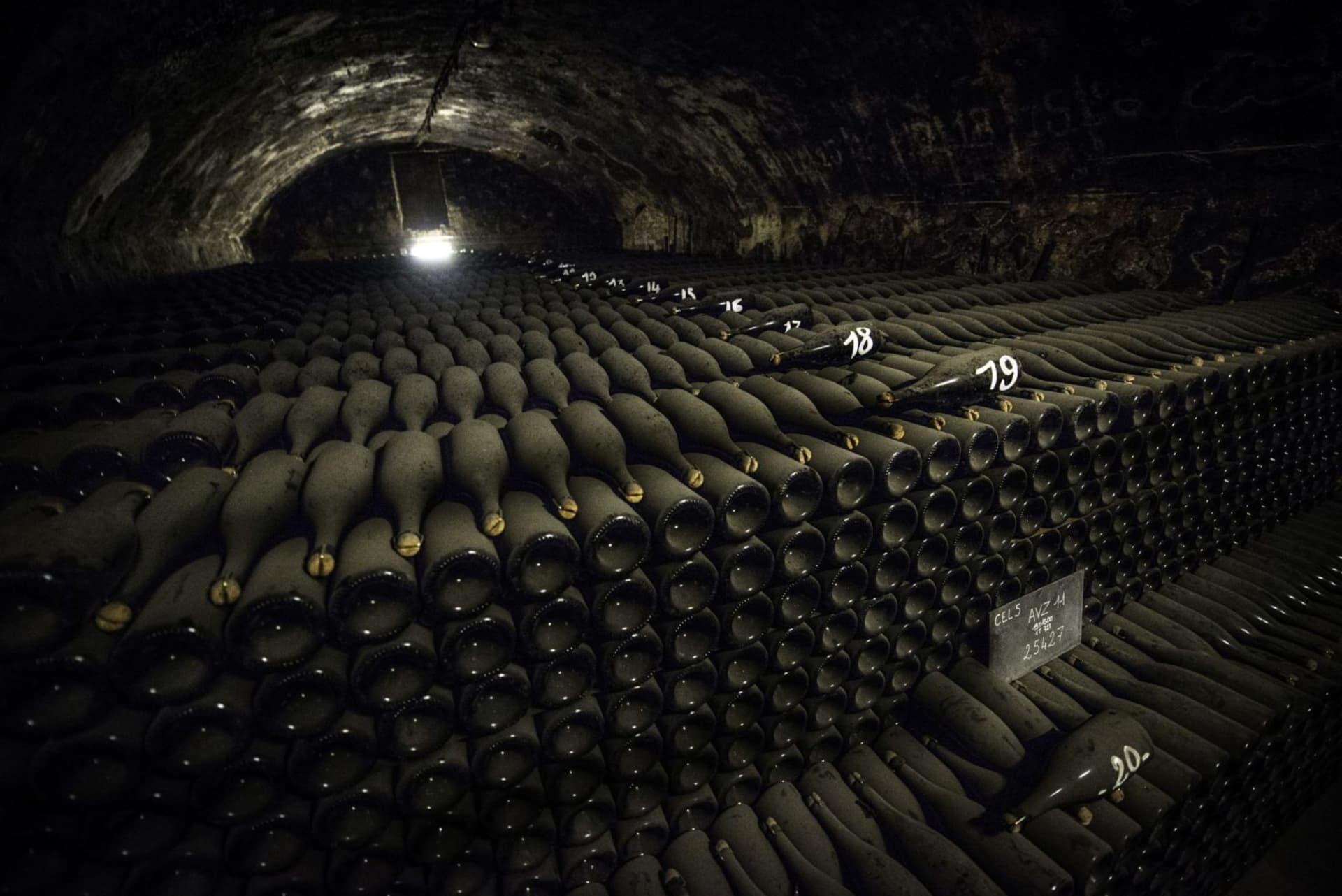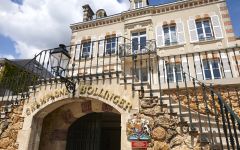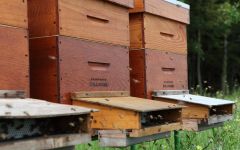Bollinger R.D. Extra Brut 2002
-
James
Suckling -
Wilfred
Wong -
Wine &
Spirits -
Wine
Spectator -
Jeb
Dunnuck -
Robert
Parker - Decanter



Product Details
Your Rating
Somm Note
Winemaker Notes
The 2002 Bollinger R.D. displays golden hue with subtle highlights. Aromas of stewed ripe fruit, particularly quince, but also a discreet note of honey. These are followed by roasted notes of cocoa, which give way to flavors of star anise and nutmeg. Full bodied attack. Powerful but well-balanced, with persistent flavor. Mineral finish with touches of lemon revealing a pleasing bitterness.
60% Pinot Noir, 40% Chardonnay
Professional Ratings
-
James Suckling
Super fresh, this is striking given the 10 years in the cellars; it has a fine citrus nose - plenty of lemon, grapefruit, yellow chalky notes, some lighter floral elements too. The palate is super dry (dosage at 3-4g) and there's a silky, sherbet-like texture, smooth, fine and long. The citrus flavours give way to the driving surging acidity, thunderous acidity, really driving and powerful. The finish twists very slowly through to light-toasted cashew fruit flavours, but lemon citrus prevails. This is thrilling Champagne. Disgorged 22nd October, 2013. Drink from 2016.
-
Wilfred Wong of Wine.com
Bollinger R.D. turned out to be my wine of the evening as I tasted a star-studded cast of the world's greatest wines at the 12 Annual Wine & Spirits Top 100 Tasting. The 2002 became a magical experience when paired with freshly shucked oysters from the Hog Island Oyster Bay Company. R.D. and I became frozen in time while everyone fought to get more wine and posing for selfies. Champagne on the highest of pedestal. James Bond (007) would have been so proud. Deep yellow golden color; delicate and refined mousse; tremendous aroma of creamy apples and subtle citrus, medium to full bodied, layered and satiny smooth on the palate; long and enticing; dry, fine acidity, well balanced; creamy, ripe core fruit flavors, with a special interplay between fruit, earth and oak; long finish, delicate and refined in the aftertaste. (Tasted: October 20, 2015, San Francisco, CA)
-
Wine & Spirits
When we tasted the 2002 Grande Année in 2012, I scored it 95 points, impressed by its pale chalk power, its muscularity and the freshness it expressed as a ten-year-old wine. It had the scent of a sunny meadow. With two years of additional time on the lees and a lower dosage, the current R.D. version of that wine is more extreme. If you break it apart you might consider how the barrel-aged base wines from 23 crus intensify the structure, or how the acidity of the vintage has sustained the bright, buzzing freshness of the peach and apple flavors. The fruit seems to be wedded to rock, so strong is the chalk streak of limestone. And yet the resonance of the wine, subsuming any and all of those factors, brings it together in a sumptuous texture, making it a pleasure to drink even now. It’s more sensible, however, to wait. In ten years, this should begin to fulfill its promise, at the start of its prime.
-
Wine Spectator
A racehorse of a Champagne, showing ample power in a sleek, harmonious package. This is structured by firm, steely acidity, seamlessly woven with concentrated layers of roast almond, crushed black raspberry, candied kumquat and ginger, fleur de sel and pastry flavors. Mouthwatering, with a lasting, spiced finish. Disgorged October 22, 2013. Drink now through 2030.
-
Jeb Dunnuck
A wine that really needs time in the glass to show at its best, Bollinger’s 2002 RD comes from a total 23 different crus (71% being Grand Cru) and is a 60/40 split of Pinot Noir and Chardonnay. Disgorged in 2013 after spending 11 years in bottle, it offers a dry, savory style that quickly morphs toward more stone fruits, toasted nuts, dried earth and exotic spices. Deep, pure, and incredibly chiseled on the palate, with a gorgeous texture and great finish, this is a Champagne I’d decant if drinking anytime soon. The dosage is in the 3-4 grams range, and while it’s certainly on the dry/savory end of the spectrum, it offers incredible complexity and depth.
-
Robert Parker's Wine Advocate
I've encountered some bottle variation with Bollinger's 2002 Extra-Brut R. D., but this example, disgorged in 2016, was showing especially well, offering up a deep bouquet of dried fruits, orange zest, mocha, spices, English walnuts and hazelnuts. Full-bodied, broad and enveloping, with a pillowy, seamless profile and a fleshy core, it concludes with a long, sapid finish. With two grams per liter less acidity than the more incisive 2008 (which has not yet been released as R. D.), the 2002 is a giving, expansive wine that is drinking well today.
Best After 2015
-
Decanter
A closed, grassy nose at first but underneath there's a restrained beautiful sophistication and youthful charm. Distinct but faint RD tones towards mushroom truffle and mineral saltiness. Slowly booming in the glass and not unlike a young RD 1975, so at some point this wine will breathe sweetest chocalte and nut symphony.
Other Vintages
2008-
James
Suckling -
Robert
Parker -
Jeb
Dunnuck - Decanter
-
Wine
Spectator
-
Robert
Parker -
Wine
Spectator
-
Wine
Spectator
-
Robert
Parker -
Wine
Spectator -
Wine
Enthusiast
-
Wine
Spectator
-
Robert
Parker
-
Wine
Spectator









In 1829, Champagne Bollinger introduced an instantly recognizable, dry, toasty style that connoisseurs around the globe have coveted ever since. Six generations of the Bollinger family have maintained that trademark style, and Bollinger is one of the rare Grande Marque houses to be owned, controlled and managed by the same family since it was founded.
With 399 acres of vineyards situated in the best Grands Crus and Premiers Crus villages, Bollinger relies on its own estate for nearly two-thirds of its grape requirements, including the Pinot Noir that gives its Champagne its distinctive roundness and elegance. Bollinger is one of a select few houses that can control the quality of its grape supply so carefully.
Bollinger is renowned for its stringent quality standards. It adheres to traditional methods, including individual vinification of each marc and cru, barrel fermentation (it is the last Champagne house to employ a full-time cooper) and extra-aging on the lees prior to disgorgement.
Members of the British Royal Court were among the first to embrace Bollinger’s unmistakable quality, and Queen Victoria made Bollinger the exclusive purveyor to the Court by Royal Warrant in 1884. Besides royalty, loyal devotees have included heads of state, celebrities and even famous fictional characters: Agent 007, James Bond, demands the exclusive Champagne Bollinger.
